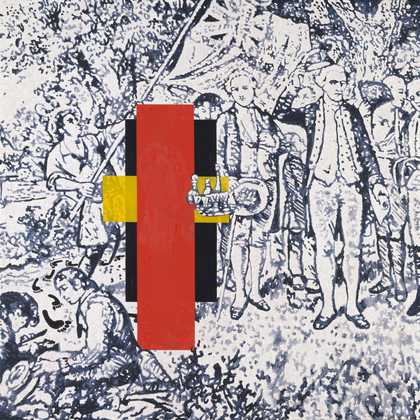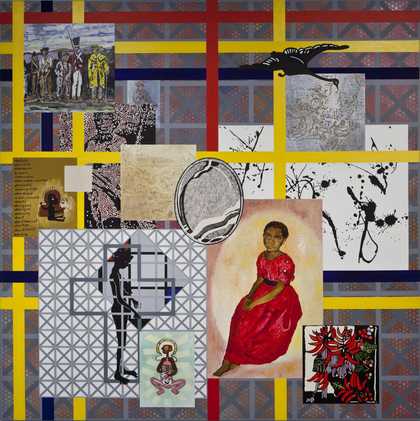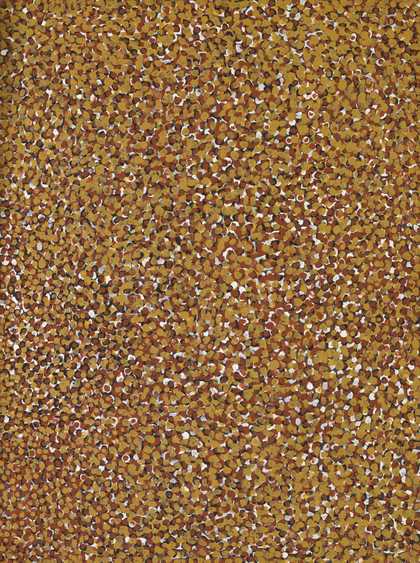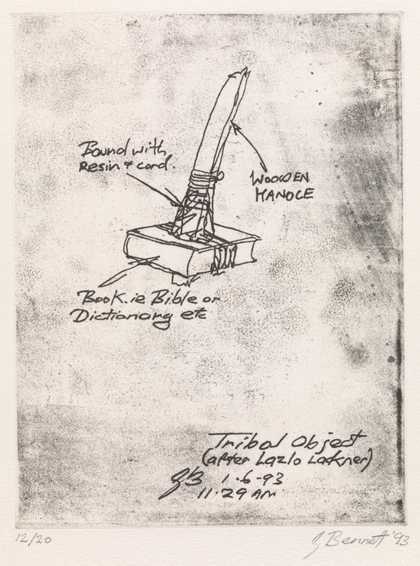
Gordon Bennett
Possession Island (Abstraction) (1991)
Tate
The ancient rock shelters of Juukan Gorge in Western Australia have been inhabited by Puutu Kunti Kurrama and Pinikura people for 46,000 years. In May 2020, Rio Tinto, the world’s largest iron-ore miner, blew up these sacred sites, sparking renewed tension between traditional landowners and mining corporations in Australia. Such violations of native title (the recognition by Australian law that Aboriginal and Torres Strait Islanders have pre existing rights to the land and waters according to their traditional laws and customs) have propelled many artists in recent decades to question the ethical foundations of Australia’s legal system, and whom it purports to benefit. Yet this discord is a short chapter in the long history of Australia’s First Nations and artists continue to assert and celebrate their ancient lineages and their relationship to country.
John Mawurndjul’s contemporary bark painting Buluwana, Female Ancestor 1989 exemplifies and embodies the notion of a continuous connection to living culture. Mawurndjul (b.1951), a Kuninjku artist from Arnhem Land in the Northern Territory, depicts his ancestor Buluwana with pigments created from his country, painted on fibrous bark taken from the Eucalyptus tetrodonta or Darwin stringybark tree. Mawurndjul is known for his mastery of rrark, a fine cross-hatching technique used by generations of Kuninjku artists, which he uses here to in-fill the figure of Buluwana. Mawurndjul describes his art as an intersection between the ancient lineageof his culture and contemporary practices: ‘The old ways of doing things have changed into the new ways. The new generation does things differently. But me, I have two ways. I am the old and the new.’
Around the time Mawurndjul was making Buluwana, and amid the backdrop of the bicentenary of the British colonisation of Australia, major national debates around native title were influencing a new generation of artists, including Gordon Bennett (1955–2014). Central to these debates was terra nullius (meaning ‘land belonging to no-one’), a doctrine that the British used to justify numerous territorial land grabs, including that of the continent now known as Australia. In Bennett’s painting Possession Island (Abstraction) 1991, the artist draws attention to the visual legacy of the moment Captain Cook claimed Australia for the British Crown by referring to Samuel Calvert’s (1828–1913) etching Captain Cook Taking Possession of the Australian Continent on Behalf of the British Crown A.D. 1770 c.1853–64, which is itself a copy of a now-lost painting by John Alexander Gilfillan (1793–1864).

John Mawurndjul Buluwana, Female Ancestor 1989
Earth pigments on stringybark (Eucalyptus tetrodonta)
261 × 77.6 cm
© John Mawurndjul / Copyright Agency, image courtesy Museum of Contemporary Art Australia, photo: Jessica Maurer
The original depicted an Aboriginal man serving drinks to the apparently triumphant colonisers while they hoist a British flag in celebration. In Bennett’s reworking, he paints over the man in red, yellow and black, the colours of the Australian Aboriginal flag. The addition of these protest colours, which directly reference the land, sun and people of Australia, symbolises the assertion of culture by Aboriginal and Torres Strait Islanders. Bennett also draws attention to the figure’s enduring connection to country, effectively questioning the doctrine of terra nullius, while also pointing to the legacies of this moment.
Tracey Moffatt refers to a more recent period of history in her disquieting photographic series Up in the Sky 1997. Set in a mythologised ‘outback’ amid decaying buildings, the series centres on a white woman with an Aboriginal baby. The presence of Catholic nuns in some of the photographs suggests religious intervention and raises questions about the depicted relationship: is the mother being separated from her child or has the child been fostered to her? Told in her typical cinematic style, Moffatt’s ambiguous narrative leaves the viewer to imagine how the story unfolds. For some, however, the images will evoke the dark period of the ‘Stolen Generations’– the children of Aboriginal and Torres Strait Islander descent who were forcibly removed from their families by government agencies in the early 20th century up until the mid 1970s in Australia. At the time, citizenship was denied to these families and their children were placed into institutions, such as Christian missions, in the belief that they would be assimilated into white society. On 13 February 2008, the families and communities traumatised by these policies received a formal apology from the Parliament of Australia, ‘offered as part of the healing of the nation.’
While laws are evolving, the destruction of the Juukan Gorge rock shelters illustrates the latest failings in Australia’s current legal system to protect native title, and consequently First Nations people’s relationship to the land. Despite, or because of this, artists like Mawurndjul, Bennett and Moffatt amplify the endurance, richness and complexity of connection to country amidst the ongoing legal and cultural controversies around Australian land rights, as well as providing a perspective on post-colonial identity for Aboriginal and Torres Strait Islander Australians.
A Year in Art: Australia 1992, Tate Modern, from 15 February. Co-curated by Valentina Ravaglia, Tamsin Hong and Sook-Kyung Lee. Research supported by Hyundai Tate Research Centre: Transnational in partnership with Hyundai Motor. The display features many works of art jointly acquired by Tate and MCA Australia through an innovative partnership established in 2015 via a gift from the Qantas Foundation.
Tamsin Hong is Assistant Curator, International Art (Performance), Tate Modern.



